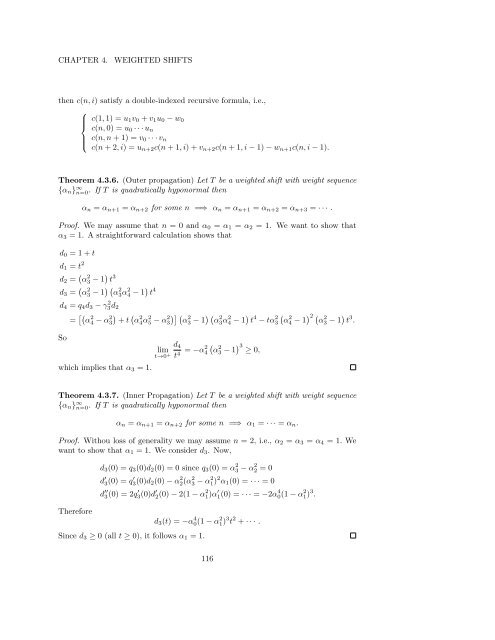Woo Young Lee Lecture Notes on Operator Theory
Woo Young Lee Lecture Notes on Operator Theory
Woo Young Lee Lecture Notes on Operator Theory
You also want an ePaper? Increase the reach of your titles
YUMPU automatically turns print PDFs into web optimized ePapers that Google loves.
CHAPTER 4.<br />
WEIGHTED SHIFTS<br />
then c(n, i) satisfy a double-indexed recursive formula, i.e.,<br />
⎧<br />
c(1, 1) = u 1 v 0 + v 1 u 0 − w 0<br />
⎪⎨<br />
c(n, 0) = u 0 · · · u n<br />
c(n, n + 1) = v 0 · · · v n<br />
⎪⎩<br />
c(n + 2, i) = u n+2 c(n + 1, i) + v n+2 c(n + 1, i − 1) − w n+1 c(n, i − 1).<br />
Theorem 4.3.6. (Outer propagati<strong>on</strong>) Let T be a weighted shift with weight sequence<br />
{α n } ∞ n=0. If T is quadratically hyp<strong>on</strong>ormal then<br />
α n = α n+1 = α n+2 for some n =⇒ α n = α n+1 = α n+2 = α n+3 = · · · .<br />
Proof. We may assume that n = 0 and α 0 = α 1 = α 2 = 1. We want to show that<br />
α 3 = 1. A straightforward calculati<strong>on</strong> shows that<br />
d 0 = 1 + t<br />
d 1 = t 2<br />
d 2 = ( α 2 3 − 1 ) t 3<br />
d 3 = ( α 2 3 − 1 ) ( α 2 3α 2 4 − 1 ) t 4<br />
d 4 = q 4 d 3 − γ 2 3d 2<br />
So<br />
= [( α 2 4 − α 2 3)<br />
+ t<br />
(<br />
α<br />
2<br />
4 α 2 5 − α 2 3)] (<br />
α<br />
2<br />
3 − 1 ) ( α 2 3α 2 4 − 1 ) t 4 − tα 2 3<br />
(<br />
α<br />
2<br />
4 − 1 ) 2 (<br />
α<br />
2<br />
3 − 1 ) t 3 .<br />
which implies that α 3 = 1.<br />
d 4<br />
lim<br />
t→0 + t 4 = ( −α2 4 α<br />
2<br />
3 − 1 ) 3<br />
≥ 0,<br />
Theorem 4.3.7. (Inner Propagati<strong>on</strong>) Let T be a weighted shift with weight sequence<br />
{α n } ∞ n=0. If T is quadratically hyp<strong>on</strong>ormal then<br />
α n = α n+1 = α n+2 for some n =⇒ α 1 = · · · = α n .<br />
Proof. Withou loss of generality we may assume n = 2, i.e., α 2 = α 3 = α 4 = 1. We<br />
want to show that α 1 = 1. We c<strong>on</strong>sider d 3 . Now,<br />
Therefore<br />
d 3 (0) = q 3 (0)d 2 (0) = 0 since q 3 (0) = α 2 3 − α 2 2 = 0<br />
d ′ 3(0) = q ′ 3(0)d 2 (0) − α 2 2(α 2 3 − α 2 1) 2 α 1 (0) = · · · = 0<br />
d ′′<br />
3(0) = 2q ′ 3(0)d ′ 2(0) − 2(1 − α 2 1)α ′ 1(0) = · · · = −2α 4 0(1 − α 2 1) 3 .<br />
Since d 3 ≥ 0 (all t ≥ 0), it follows α 1 = 1.<br />
d 3 (t) = −α 4 0(1 − α 2 1) 3 t 2 + · · · .<br />
116













